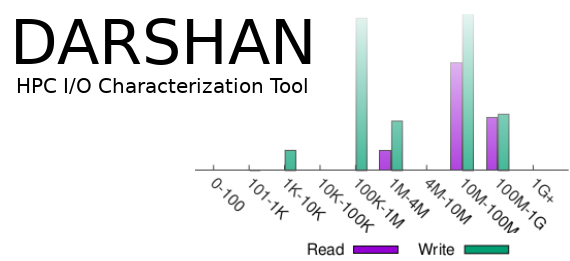The Darshan project now has a dedicated mailing list and Trac page. You can find more information in the “bug reports” tab at the top of the Darshan web site.
Darshan 1.1.15 release
Changelog:
- bug fixes to darshan-gen-cc.pl and darshan-gen-cxx.pl
- basic testing of darshan-gen-cc.pl with mpich/pgi
- update autoconf so that –with-mpi argument overrides mpicc in path
- fix warnings on 64 bit machines
Darshan 1.1.15 is now available on the download page.
Darshan 1.1.14 release
Changelog:
- fixed erroneous incompatibility warning when opening old logs in darshan-parser
Darshan 1.1.14 is now available on the download page.
Darshan 1.1.13 release
Changelog:
- updated compiler scripts to fix link order in some cases with -lhdf5
Darshan 1.1.13 is now available on the download page.
Darshan 1.1.12 release
Changelog:
- improved mapping of file records to mount points
- new page in darshan-job-summary.pl output showing timelines of file access
- bug fix to “fast” mpif90 script
- checkpoint/restart ability in parallel fsstats script
Darshan 1.1.12 is now available on the download page.
Darshan 1.1.11 release
Changelog:
- Bug fix for lseek, pread, and pwrite when used in 32 applications without large file support
- Improved experimental darshan-gen-cc.pl script
- Added new experimental darshan-gen-cxx.pl script
Darshan 1.1.11 is now available on the download page.
Darshan 1.1.10 release
Changelog:
- Bug fix for files that are accessed with stat() but never opened
- Work around zlib problems with 64 bit offsets on 32 bit architectures
Darshan 1.1.10 is now available on the download page.
Production deployment updates
Darshan has been successfully deployed on both the Surveyor and Intrepid BG/P systems at Argonne National Laboratory as of January 14, 2010! This means that all newly compiled applications are using Darshan by default on those systems.
Upcoming development work will be focused on how to mine the Darshan data to learn more about how users perform I/O at leadership scale.
Darshan 1.1.9 release
Changelog:
- Added “fast” version of each BG/P compiler
- Added experimental scripts in test directory to run fsstats in parallel
- Kevin Harms: Added experimental utilities for loading darshan results into SQL
- Use exclusive flag when opening output file (to protect against file name collision)
- Rob Ross: updates to allow command line tools to build on Darwin
- Bug fix for pnetcdf configure problem reported by Rob Latham; darshan now always pulls in MPI_Wtime() symbol at link time
Darshan 1.1.9 is now available on the download page.
Darshan 1.1.8 release
Changelog:
- Added tracking of file system type and mount point for each file
- Added tracking of file size at open time (CP_SIZE_AT_OPEN)
- Moved sync cost to be counted in cumulative write time rather than cumulative metadata time
- Added sync as a separate category in darshan-job-summar.pl counters
- Bug fix to most frequent access size table in darshan-job-summary.pl
- Converted all utilities to use darshan-logutils api for reading output files
- Added backwards compatibility to darshan-logutils routines
- Kevin Harms: Added darshan-analyzer utility to summarize usage of MPI-IO, pNetCDF, HDF5, and shared files across a set of output files
- Fixed bug field listing for darshan-diff utility
Darshan 1.1.8 is now available on the download page.
